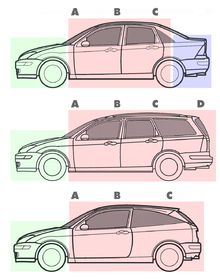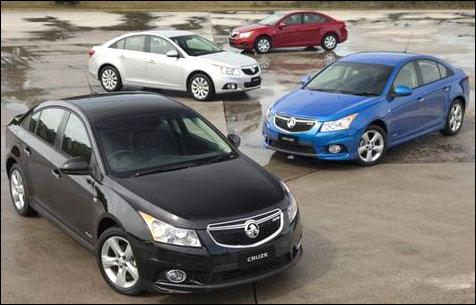Cars have now been identified by their body styles and size. There are different types of body styles available in India like Sedans, SUVs, Coupes, Convertibles, Hatchbacks, Wagons, Multi-utility vehicle or Multi-purpose vehicle.
Hatchbacks are designed with a passenger cabin and an integrated cargo space which can be accessed from behind the vehicle by a single, top-hinged tailgate or large flip-up window. Hatchbacks commonly have two rows of seats and frequently include fold-down rear seats, which enable a substantial portion of the interior space to be used as a cargo area. Usually, the rear seat can be folded completely to expand the cargo space. The typical hatchback roof rakes down steeply behind the C-Pillar, resulting in very little car length behind the rear wheels and thus no room for a side window over the load area. The tailgate is also referred to as the hatch. Hatchbacks are often described as three-door with two entry doors or five-door with four entry doors cars.
Examples: Maruti Swift, Chevrolet Beat, Hyundai i10, Volkswagon Polo, Tata Indica etc.
Sedan / Saloon
Sedan is a passenger car that comprises with two rows of seats and enough space in the rear for adult passengers. The roof structure of a sedan will typically have a fixed “B” pillar on all the sedan models and comes usually with a good trunk space. Some examples for sedans in India are Audi A4, A8, BMW 3 and 5 series, Ford Fiesta, Hyundai Accord cars. The sedans are mostly four-door and two-door models.
Examples: Honda City, Hyundai Verna, Tata Indigo, Volkswagon Vento etc.




.jpg)





Hatchback
Hatchbacks are designed with a passenger cabin and an integrated cargo space which can be accessed from behind the vehicle by a single, top-hinged tailgate or large flip-up window. Hatchbacks commonly have two rows of seats and frequently include fold-down rear seats, which enable a substantial portion of the interior space to be used as a cargo area. Usually, the rear seat can be folded completely to expand the cargo space. The typical hatchback roof rakes down steeply behind the C-Pillar, resulting in very little car length behind the rear wheels and thus no room for a side window over the load area. The tailgate is also referred to as the hatch. Hatchbacks are often described as three-door with two entry doors or five-door with four entry doors cars.
Examples: Maruti Swift, Chevrolet Beat, Hyundai i10, Volkswagon Polo, Tata Indica etc.
Sedan / Saloon
Examples: Honda City, Hyundai Verna, Tata Indigo, Volkswagon Vento etc.
MUV/MPV


MPV stands for multi-purpose vehicle. MUV (multi-utility
Vehicle) is similar in shape to a van that is designed for personal use. So
basically they are taller than a sedan, hatchback or a station wagon, designed
for maximum interior room in order to fit in more occupants in the car. MUVs are considered the best over other vehicles for long trips with family
members and friends.
Example: Maruti Ertiga, Toyota Innova etc.
SUV
SUV stands for Sport Utility Vehicle, is a passenger vehicle
that perfectly blends towing and hauling capacity of a pick up truck with the
passenger carrying space of a minivan or
station wagon with excellent on or off-road capabilities. These are designed
with a combined passenger and cargo compartment. Utility vehicles are rapidly
capturing the market due to its multifarious use. Most of the SUVs have three
rows of seats with a spacious cargo area behind the third or last row of seats.
Examples: Tata Safari, Mahindra XUV, Honda CRV etc.
Convertibles
.jpg)

Convertibles comes with flexible operating roof. If the top
is made of strong or rigid material as steel, it is called retractable hardtop.
With the press of a button it can be converted into coupe or convertible. The
collapsible roof section is usually made from flexible canvas or vinyl or an
articulated folding frame. Now most of the modern vehicles come with an
electrical retraction mechanism. When the top is erected it is secured to the
windshield frame header with automatic or manual latches.
Coupe


The coupes are the cars which are reduced from 4 doors to 2
doors offering either two seats or 4 seating that includes space for two
passengers in the front and two in the rear. They are often called as sporty
version of sedans.
Crossovers


A crossover (or CUV: crossover utility vehicle) is a vehicle
built on a car platform and combining, in highly variable degrees, features of
a sport utility vehicle (SUV) with features from a passenger vehicle,
especially those of a station wagon or hatchback. Using the unibody construction typical of passenger
vehicles, the crossover combines SUV design features such as tall interior
packaging, high H-point seating, high ground-clearance or all-wheel-drive
capability — with design features from an automobile such as a passenger
vehicle's platform, independent rear suspension, car-like handling and fuel
economy.
Classification of Car Segments
As per SIAM (Society of Indian Automobile Manufacturers)
The classification of segments are done as per length of the vehicle, (Passenger car segment)
A1 - Mini - Upto 3400mm (M800, Nano)
A2 - Compact - 3401 to 4000mm (Alto, wagon r, Zen,i10,A-star,Swift,i20,palio,indica etc)
A3 - Midsize - 4001 to 4500mm (City,Sx4,Dzire,Logan,Accent,Fiesta,Verna etc)
A4 - Executive - 4501 to 4700mm (Corolla,civic,C class,Optra,Octavia, etc)
A5 - Premiun - 4701 to 5000mm (Camry,E class,Accord,Sonata,Laura,Superb,etc)
A6 - Luxury - Above 5000mm (S class,5 series etc)
B1 - Van - Omni, Versa, Magic etc
B2 - MUV/MPV - Innova, Tavera, Sumo etc
SUV - CRV, Vitara etc
Source: shemimon on carwale.com


